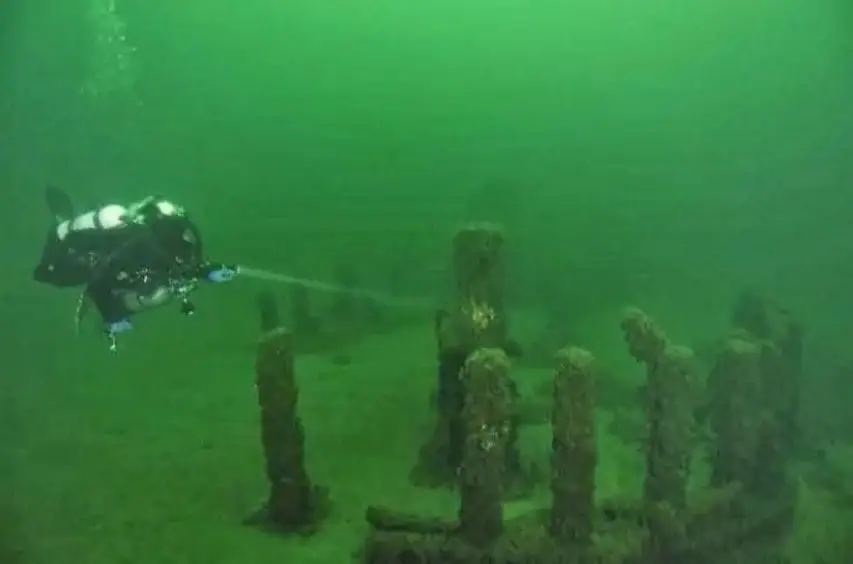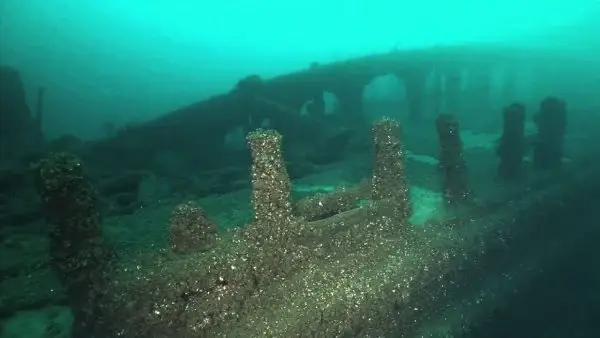Beneath the calm, glistening waters of Grand Traverse Bay, something remarkable has emerged from the depths—a prehistoric enigma that could rewrite what we thought we knew about the region’s ancient past.
Nicknamed “Michigan’s Stonehenge,” this newly uncovered structure is sparking fascination, skepticism, and no small amount of curiosity.
Dr. Mark Holley, an underwater archaeology professor from Northwestern Michigan University, led the discovery. Forty feet below the surface of Lake Michigan, his team found a series of carefully arranged stones stretching over a mile, some as small as basketballs, others the size of compact cars.
Their deliberate placement raises an obvious question: who put them there, and why?
“It’s not just their arrangement that’s intriguing,” Dr. Holley noted, “but one stone in particular—it’s carved.” This isn’t just any carving, either. The massive stone, standing over 3.5 feet tall and nearly 5 feet wide, features a depiction of a mastodon.
Yes, a mastodon—an ancient creature that roamed the area thousands of years ago. This carving ties the structure to a time when humans shared the landscape with these prehistoric giants.
What’s more astonishing is the age of the stones. They’re estimated to be around 9,000 years old, predating England’s iconic Stonehenge by about 4,000 years.
To put it in perspective, this structure was built when Grand Traverse Bay wasn’t even underwater yet, right after the Ice Age melted its grip on the region.

An Ancient Puzzle Beneath Modern Waters
Grand Traverse Bay, famous today for its shipwreck dive sites, has always been a magnet for explorers. Stretching 32 miles long and 12 miles wide, its history as a hub of maritime trade is well-documented.
But this new discovery thrusts the bay’s story even further back in time. What civilization could have placed these stones? And for what purpose—a calendar, a ceremonial site, or something we’ve yet to imagine?
Dr. Holley and his team haven’t rushed to conclusions, nor have they disclosed the exact location of the site.
The secrecy is intentional. After the discovery, Dr. Holley contacted the Grand Traverse Band of Ottawa and Chippewa tribes to honor their ancestral connection to the area. Protecting the site from vandalism and overzealous curiosity seekers is paramount.
A Discovery That Raises More Questions Than Answers
Of course, discoveries like this are bound to attract both excitement and skepticism. The arrangement of the stones might seem deliberate, but natural processes can sometimes play tricks on the eye.
Could shifting glacial activity or underwater currents be responsible for what looks like intentional placement? And the mastodon carving—is it really as old as it seems, or could it be a coincidence?
For now, the stones remain a mystery, tucked away in the depths of Grand Traverse Bay. What they represent—be it a glimpse into a forgotten civilization or an extraordinary geological coincidence—will continue to fuel debate.
One thing is certain, though: the discovery has captivated imaginations and reminded us how much of the past remains hidden, waiting for curious minds to uncover it.
1 Cathie Wood and Warren Buffett Stock That Could Go Parabolic in 2025



